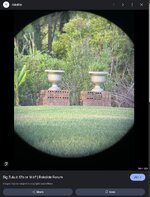I'm about to pull the trigger on either the 12x or 16x Zulu6 HDX (last gen).
There are a bunch of threads here but I couldn't find anything definitive on the low-light performance of one vs. the other. There seemed to be a picture comparison - see attached photo - that was captured by google but when I click through, it was inexplicably deleted in the thread "Sig Zulu 6 12's or 16's?"
Would love to get the braintrust's opinion on this.
Questions
Does anyone know how much worse the 16x is at low light (I'm leaning towards these) practically?
Does the extra mag make up for the reduction in low-light performance?
Use Case
If I buy the 16's, I'll be doing so in lieu of a Razor mini spotter. I'd keep my current LRF bino for rifle hunting, use the 16s as a pack spotter. When scouting, I’d just bring the 16s.
If I buy the 12's, I'd replace the LRF binos on my chest and probably get the Sig Kilo 4k rangefinder (OIS) and either the Razor mini spotter or a pair of 15x56s.
These will be used for western hunting -- mountains, canyons, some timber in between etc.
There are a bunch of threads here but I couldn't find anything definitive on the low-light performance of one vs. the other. There seemed to be a picture comparison - see attached photo - that was captured by google but when I click through, it was inexplicably deleted in the thread "Sig Zulu 6 12's or 16's?"
Would love to get the braintrust's opinion on this.
Questions
Does anyone know how much worse the 16x is at low light (I'm leaning towards these) practically?
Does the extra mag make up for the reduction in low-light performance?
Use Case
If I buy the 16's, I'll be doing so in lieu of a Razor mini spotter. I'd keep my current LRF bino for rifle hunting, use the 16s as a pack spotter. When scouting, I’d just bring the 16s.
If I buy the 12's, I'd replace the LRF binos on my chest and probably get the Sig Kilo 4k rangefinder (OIS) and either the Razor mini spotter or a pair of 15x56s.
These will be used for western hunting -- mountains, canyons, some timber in between etc.

